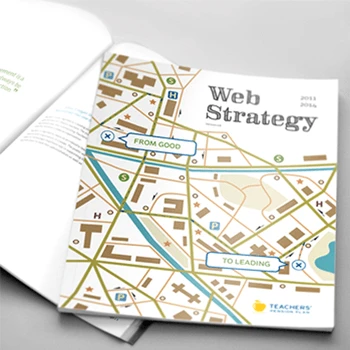What exactly is web strategy and why do we need it?
Web strategy is the systematic planning of how your web portal will serve users and achieve business goals. Through our Experience Thinking framework, we examine how users will experience your brand, content, product, and service through the web portal. Every web portal needs strategic direction to become a go-to resource that connects users with information they need effectively.
Tip: Start by mapping your current web portal against actual user journeys rather than internal organizational structure to identify strategic gaps.
How does web strategy differ from web design?
Web strategy focuses on the 'why' and 'what' - understanding user needs, business goals, and content strategy before any visual design begins. Design addresses the 'how' - the visual and interactive execution of the strategy. Strategy ensures your web portal has purpose and direction, while design makes that strategy tangible and usable.
Tip: Always complete strategic planning before beginning visual design to avoid costly redesigns when fundamental issues surface later.
Why should we invest in web strategy rather than just improving our current site?
Web strategy addresses root causes rather than symptoms. Improving a poorly planned site often amplifies existing problems. Strategic planning through our Experience Thinking approach examines your complete digital ecosystem - how brand, content, product, and service experiences connect. This foundation prevents recurring issues and creates sustainable competitive advantage.
Tip: Audit how well your current site supports the complete customer lifecycle from awareness to advocacy, not just individual tasks.
What role does user research play in web strategy development?
User research forms the foundation of effective web strategy by revealing actual user needs, behaviors, and mental models. We use ethnographic analysis, journey mapping, and behavioral research to understand how users think about information and tasks. This research directly informs content organization, functionality priorities, and interaction design decisions.
Tip: Include users from different experience levels and use contexts in your research rather than focusing only on your most frequent users.
How do we know if our current web strategy is working?
Effective web strategy measurement goes beyond traffic metrics to include task completion rates, user satisfaction across the experience lifecycle, and business goal achievement. We establish baseline measurements for user efficiency, content findability, and conversion paths. Regular usability testing reveals whether the strategy translates into actual user success.
Tip: Create measurement frameworks that track both user experience quality and business outcomes rather than just monitoring website activity statistics.
What happens when we don't have a clear web strategy?
Without strategy, web portals evolve reactively, creating disconnected experiences that confuse users and waste resources. Content becomes difficult to find, functionality duplicates across sections, and user needs go unmet. The result is declining user engagement, increased support costs, and missed business opportunities as users abandon tasks or choose competitors.
Tip: If you're experiencing increasing user complaints or declining task completion rates, strategy development should be your first priority before making tactical changes.
How does artificial intelligence impact web strategy planning?
AI transforms web strategy by enabling personalized experiences, predictive content delivery, and automated user assistance. Strategic planning must now consider how AI will enhance user experiences without replacing human decision-making in complex scenarios. We help organizations integrate AI capabilities while maintaining authentic brand expression and user control.
Tip: Focus AI integration on enhancing user efficiency and content discovery rather than trying to automate every user interaction.
How do you plan for the complete user experience lifecycle?
We apply Experience Thinking to map the journey from customer to user to client, ensuring each lifecycle stage has appropriate content, functionality, and support. Initial awareness requires different strategic approaches than ongoing usage or advocacy phases. This lifecycle perspective prevents gaps that cause user abandonment at critical transition points.
Tip: Map your web strategy against the complete relationship lifecycle rather than just the initial conversion to identify long-term engagement opportunities.
What's your approach to content strategy within web strategy?
Content strategy focuses on how information is packaged and consumed across different contexts and user needs. We examine existing content assets, map user journeys, and develop governance frameworks that prioritize audience needs. Through our Experience Thinking approach, content becomes a strategic experience rather than just information delivery.
Tip: Organize content according to user mental models and task flows rather than internal organizational structure to improve findability.
How do you ensure brand consistency throughout the web experience?
Brand experience through web strategy involves expressing core values, differentiation, and emotional connection consistently across all touchpoints. We develop brand expression guidelines that translate personality traits into interaction patterns, content voice, and user interface decisions. This creates cohesive experiences that build trust and recognition.
Tip: Define your brand personality traits first, then translate these into specific interaction principles and content guidelines for consistent implementation.
What role does foresight design play in web strategy?
Foresight design helps anticipate future user needs and technological changes that will impact web experiences. We use strategic foresight methods to explore emerging user behaviors, technology capabilities, and market conditions that might affect your web strategy over 3-5 year horizons. This future-oriented planning prevents obsolescence and identifies innovation opportunities.
Tip: Build flexibility into your web architecture and content systems to accommodate emerging technologies and changing user expectations.
How do you balance user needs with business requirements?
Effective web strategy aligns user success with business success by identifying mutual value creation opportunities. We examine how user task completion contributes to business goals and design experiences that serve both effectively. When conflicts arise, we facilitate stakeholder workshops to find solutions that maintain user experience quality while meeting business needs.
Tip: Focus on identifying shared success metrics where user satisfaction directly contributes to business goal achievement rather than treating them as competing priorities.
What methods do you use for validating web strategy concepts?
We validate strategy through prototyping, user testing, and stakeholder feedback before implementation. This includes card sorting for information architecture, usability testing for interaction concepts, and business model validation for strategic assumptions. Early validation reduces risk and ensures strategy translates into successful user experiences.
Tip: Test strategy concepts with real users and realistic content rather than abstract wireframes to get meaningful validation feedback.
How do you approach mobile and multi-device strategy planning?
Multi-device strategy requires understanding how users move between contexts and devices throughout their journey. We map cross-device user flows and design for experience continuity rather than device-specific optimization. This includes consideration of different input methods, screen sizes, and usage contexts that affect strategic decisions.
Tip: Design your web strategy around user tasks and contexts rather than specific devices to create more adaptable and future-ready experiences.
How do we know if our organization is ready for web strategy work?
Organizational readiness involves leadership commitment, resource allocation, and stakeholder alignment around user-centered decision making. We assess current decision-making processes, content governance capabilities, and technical infrastructure maturity. Readiness includes willingness to make changes based on user research findings rather than just internal preferences.
Tip: Ensure you have executive sponsorship and dedicated resources before beginning strategy development to avoid stalled implementation.
What internal capabilities do we need for ongoing strategy success?
Successful strategy implementation requires user research capabilities, content management processes, and design system maintenance. We help organizations develop internal expertise in user testing, analytics interpretation, and iterative improvement processes. This includes training existing staff and establishing governance frameworks for strategic decision-making.
Tip: Invest in building internal user research and content strategy capabilities rather than depending entirely on external support for ongoing strategy evolution.
How do you help align stakeholders around web strategy decisions?
Stakeholder alignment requires shared understanding of user needs, business goals, and strategic priorities. We facilitate workshops that combine user research insights with business strategy discussions, creating common language and shared success metrics. This alignment process includes developing decision-making frameworks that stakeholders can use independently.
Tip: Create shared stakeholder experiences of user research findings rather than just presenting reports to build genuine empathy and commitment to user-centered decisions.
What governance structures support effective web strategy?
Web strategy governance includes content management processes, design system maintenance, and strategic review cycles. We help establish decision-making authorities, quality standards, and update processes that maintain strategic coherence as organizations grow and change. Governance balances consistency with innovation flexibility.
Tip: Design governance systems that focus on outcomes and principles rather than detailed process requirements to maintain flexibility while ensuring quality.
How do you handle resistance to strategy-driven changes?
Change resistance often stems from unclear value propositions and established workflows rather than opposition to better user experiences. We address resistance through demonstration, pilot programs, and partnership approaches that show incremental value while building organizational confidence in user-centered decision making.
Tip: Start with small, visible improvements that demonstrate strategy value rather than attempting organization-wide changes immediately.
What role does leadership play in web strategy success?
Leadership provides strategic vision, resource allocation, and organizational change support necessary for strategy implementation. We work with leaders to develop user experience advocacy skills, business case communication approaches, and change management strategies that sustain strategic focus throughout implementation challenges.
Tip: Ensure leadership understands and can communicate the business value of user-centered strategy to maintain organizational support during implementation.
How do you structure web strategy implementation phases?
Implementation follows strategic priorities with quick wins balanced against foundational changes. We typically begin with information architecture and content strategy, then move to interaction design and visual implementation. Each phase includes user validation and stakeholder review to ensure strategy translates effectively into experience improvements.
Tip: Plan implementation phases that deliver user value incrementally rather than waiting for complete strategy implementation to show results.
What's your approach to content migration and optimization?
Content migration involves auditing existing content, mapping to new information architecture, and optimizing for user needs rather than just technical transfer. We develop content guidelines, governance processes, and quality standards that ensure migrated content serves strategic goals. This includes content gap analysis and creation planning.
Tip: Use content migration as an opportunity to eliminate outdated material and optimize content for user tasks rather than just moving everything to a new structure.
How do you integrate web strategy with existing technology systems?
Technology integration requires understanding current system capabilities and constraints while planning for strategic requirements. We work with technical stakeholders to identify integration opportunities, system limitations, and upgrade priorities that support strategic goals. This includes API planning and data flow optimization.
Tip: Evaluate technology decisions based on their ability to support user experience goals rather than just technical features or vendor relationships.
What support do you provide during strategy implementation?
Implementation support includes design quality assurance, user testing facilitation, and strategic guidance throughout development cycles. We provide ongoing consultation on strategic decisions, help resolve implementation challenges, and ensure final results match strategic intentions. This includes training and knowledge transfer.
Tip: Plan for ongoing strategic consultation during implementation rather than assuming strategy documents alone will guide successful execution.
How do you measure implementation success?
Success measurement includes both user experience improvements and business goal achievement. We establish baseline metrics, track implementation progress, and validate strategic assumptions through user testing and analytics analysis. Success includes process improvements like faster content updates and reduced support needs.
Tip: Create measurement frameworks that connect user experience improvements to business outcomes rather than just tracking implementation activity.
What happens when implementation reveals strategy gaps?
Implementation often reveals real-world constraints and opportunities not apparent during planning. We maintain strategic flexibility through iterative review processes, stakeholder communication, and adaptive planning approaches. Strategy evolution during implementation is normal and healthy when guided by user feedback and business learning.
Tip: Build strategy review cycles into implementation planning to accommodate learning and adaptation rather than treating strategy as unchangeable once approved.
How do you ensure strategy implementation maintains quality?
Quality maintenance requires ongoing design review, user testing, and strategic alignment checking throughout implementation. We establish quality criteria, review processes, and testing protocols that ensure strategic intentions translate into actual user experience improvements. This includes addressing technical constraints that might compromise strategy.
Tip: Include user experience quality checkpoints throughout development rather than discovering strategy compromises only at launch time.
What research methods inform web strategy development?
We use ethnographic analysis, journey mapping, card sorting, and usability testing to understand user mental models and behavior patterns. Research includes both qualitative insight gathering and quantitative validation to ensure strategy decisions are based on actual user needs rather than assumptions. Methods are selected based on strategic questions and organizational context.
Tip: Combine multiple research methods to understand both what users do and why they do it rather than relying on single data sources.
How do you research complex B2B user needs?
B2B research requires understanding organizational context, role relationships, and decision-making processes alongside individual user needs. We conduct stakeholder interviews, workflow analysis, and organizational journey mapping to capture the complexity of business user experiences. This includes understanding approval processes and collaborative work patterns.
Tip: Include users from different organizational levels and roles in B2B research to understand the complete decision-making and usage ecosystem.
What role does competitive analysis play in web strategy?
Competitive analysis examines experience strategies and interaction patterns rather than just feature comparison. We analyze how competitors address similar user needs, identify industry best practices, and discover opportunity gaps in the competitive landscape. This analysis informs strategic positioning and innovation opportunities.
Tip: Focus competitive analysis on user experience quality and strategic approach rather than just cataloging competitor features to identify real differentiation opportunities.
How do you validate research findings with stakeholders?
Validation involves presenting research insights alongside business implications and strategic recommendations. We facilitate stakeholder workshops that connect user research findings to strategic decisions and business goals. This includes helping stakeholders understand research limitations and confidence levels for different insights.
Tip: Present research findings with clear connections to business impact and strategic decisions rather than just sharing data without actionable conclusions.
What's your approach to ongoing research and optimization?
Ongoing research includes analytics monitoring, regular user testing, and strategic review cycles that enable continuous strategy refinement. We help organizations develop research operations capabilities that support iterative improvement without requiring external consultation for every strategic decision. This includes building internal research expertise.
Tip: Establish regular research cycles and internal capabilities rather than treating research as a one-time activity at the beginning of strategy development.
How do you research emerging user behaviors and expectations?
Emerging behavior research uses foresight design methods to explore changing user expectations, technology adoption patterns, and cultural shifts that might impact web strategy. We combine trend analysis with user interviews to understand how current behaviors might evolve and what new capabilities users might expect.
Tip: Include users who are early adopters and technology leaders in your research to understand emerging behavior patterns that might become mainstream.
How does web strategy influence technology architecture decisions?
Strategy informs technology choices by defining user experience requirements, content management needs, and integration capabilities that technology must support. We help evaluate technology options based on their ability to deliver strategic goals rather than just technical features. This includes considering future flexibility and scalability needs.
Tip: Evaluate technology solutions based on their ability to support user experience goals and strategic flexibility rather than just current functional requirements.
What's your approach to design system integration with web strategy?
Design systems become experience systems that encode strategic decisions about interaction patterns, content organization, and brand expression. Through our Experience Thinking approach, design systems support consistency across brand, content, product, and service touchpoints. This creates strategic platforms that enable innovation while maintaining coherence.
Tip: Design your system architecture to support strategic experience principles rather than just component efficiency to enable appropriate adaptation across different contexts.
How do you plan for web accessibility within strategy development?
Accessibility planning is integrated into strategic decisions about content organization, interaction design, and technology selection from the beginning. We ensure accessibility requirements inform strategic choices rather than being addressed as an afterthought. This includes consideration of assistive technologies and diverse user capabilities throughout strategy development.
Tip: Include accessibility requirements in your strategic planning and technology evaluation rather than treating accessibility as a separate compliance issue.
What considerations guide mobile-responsive strategy planning?
Responsive strategy focuses on task prioritization and context adaptation rather than just screen size optimization. We examine how user needs change across different contexts and design strategic approaches that maintain experience quality across devices. This includes consideration of input methods, network conditions, and usage contexts.
Tip: Plan responsive strategy around user task priorities and context needs rather than just adapting desktop experiences to smaller screens.
How do you integrate analytics and measurement into web strategy?
Analytics integration requires defining strategic success metrics and implementing measurement systems that track both user behavior and business outcomes. We help establish analytics frameworks that support strategic decision-making rather than just monitoring website activity. This includes both quantitative measurement and qualitative feedback collection.
Tip: Define strategic success metrics and measurement approaches during strategy development rather than trying to measure strategy success with existing analytics configurations.
What's your approach to performance optimization within web strategy?
Performance optimization supports strategic user experience goals by ensuring technical implementation doesn't compromise strategy execution. We consider performance requirements during strategic planning and help prioritize optimization efforts based on user impact and strategic importance. Performance becomes part of strategic success rather than just technical requirement.
Tip: Include performance requirements as strategic constraints during planning rather than addressing performance problems after strategy implementation is complete.
How do you plan for long-term web strategy evolution?
Long-term strategy evolution requires building organizational capabilities for ongoing user research, strategic review cycles, and adaptive planning processes. We help organizations develop internal expertise and governance frameworks that support strategic evolution without requiring complete re-planning. This includes anticipating future technology and user behavior changes.
Tip: Build organizational capabilities for strategy evolution rather than just implementing current strategy to ensure long-term strategic success.
What support do you provide for strategy maintenance and updates?
Ongoing support includes strategic consultation, research facilitation, and governance framework updates that help organizations maintain strategic focus as they grow and change. We provide training, documentation, and review processes that enable internal strategic management while offering consultation for major strategic decisions.
Tip: Plan for ongoing strategic consultation and review rather than treating strategy implementation as a one-time project that requires no future attention.
How do you measure long-term strategy success and ROI?
Long-term success measurement includes user satisfaction trends, business goal achievement, and organizational capability development over time. We establish measurement frameworks that track strategic impact beyond initial implementation, including efficiency gains, reduced support costs, and improved user task completion rates. ROI includes both direct revenue impact and operational improvements.
Tip: Create measurement systems that track strategic impact over multiple years rather than just measuring immediate implementation success.
What happens when business goals or user needs change significantly?
Significant changes require strategic review and adaptation processes that maintain strategic coherence while addressing new requirements. We help organizations evaluate change impact, update strategic priorities, and implement evolution plans that preserve strategic investment while adapting to new conditions. This includes stakeholder realignment and communication processes.
Tip: Build change management processes into your strategic planning rather than assuming current business goals and user needs will remain stable indefinitely.
How do you help organizations build internal strategy capabilities?
Capability building includes training, mentorship, and knowledge transfer that enables organizations to manage strategic evolution independently. We provide frameworks, tools, and processes that internal staff can use for ongoing strategic decision-making while offering consultation for complex strategic challenges. This builds sustainable strategic competence.
Tip: Focus on building internal strategic thinking capabilities rather than just implementing current strategy to ensure your organization can adapt to future challenges.
What trends in web strategy should we be preparing for?
Current trends include AI integration for personalized experiences, voice and conversational interfaces, progressive web app capabilities, and increased focus on user privacy and data protection. Through foresight design approaches, we help organizations prepare for emerging interaction patterns and technology capabilities that will affect future web strategy decisions.
Tip: Build strategic flexibility and experimentation capabilities into your organization rather than trying to predict specific technology adoptions that will affect future strategy.












